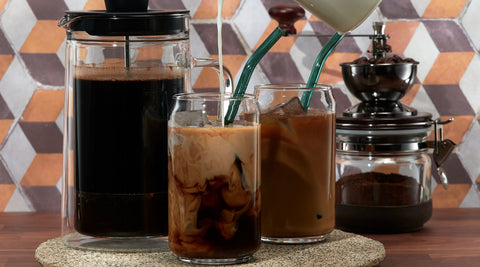Cold Brew: Getting started
If you’re looking to craft the perfect cup of French press cold brew coffee in the comfort of your own home to serve to guests, then this article and recipe duo is for you.
We will cover all the basics you need to know about making enticing coffee, from selecting quality coffee beans to how best to grind, and brewing the beverage.
You’ll learn how to make the perfect brew in a French press, from pre-soaking the beans to stirring the grounds with a spoon. Plus, we even discuss the best way to store your homemade refreshing brew so it stays fresh and ready to serve at a moment's notice.
Read on to learn all the essentials of crafting the perfect cup of French press cold brew coffee.
Brewing Summary
French press cold brew coffee is made with coarse-ground beans steeped in room-temperature water, creating a smoother and less acidic taste than regular coffee.
A French Press is an ideal coffee maker for making a French press cold brew, and the recommended ratio of coffee to water is usually 1:8.
Dilution ratios vary pertaining to personal likes and dislikes, and cold brews should be stored in a sealed container in the chill box for up to a fortnight.
What is Cold Brew Coffee?

Is it trickier than it looks?
Cold brew coffee is a simple method made by steeping coarse-ground beans in room-temperature water for 10 to 20 hours. Cold brew is made using a cold extraction process, where the coffee grounds are left to steep for a long period in the fridge.
Unlike hot-brewed coffee, cold brew(not to be confused with iced coffee) is a more concentrated recipe and we recommend diluting it with water, milk, ice, etc. before drinking.
This makes it a great choice for making iced coffee since it can be mixed with cold water or even better, crushed ice cubes.
The cold brew coffee recipe is also easier on the stomach than regular coffee. The lower temperature and lack of heat help to reduce the amount of acidity in the coffee.
This allows for a smoother and less bitter taste, which can be enjoyed by those who have difficulty drinking hot coffee.
Good to know
Cold brew coffee also has a longer shelf life in the fridge than regular coffee due to no milk that sours easily.
In addition to being served cold from the fridge with a few cubes of ice for the summer, cold brew coffee can also be served hot. This makes it an adaptable drink that you can pour and enjoy any time of the day.
Although some people may prefer to make cold brew coffee with boiled water, it is not necessary.
Difference between regular coffee and cold brew
The main distinction between regular coffee and cold brew is that cold brews are steeped with cold water and never exposed to heat, whereas regular coffee is brewed with hot water and milk added at a later stage.
Cold brew does not require boiling water and is instead made with room temperature or cool water. This creates a coffee concentrate that is twice as strong as a regular cup of hot coffee.
When making cold brew, it is important to use coarsely ground beans.
This helps to ensure that the full-bodied oils of the beans are extracted during the cold extraction stage. In contrast, regular coffee requires finely ground coffee beans.
The hot water used for regular coffee helps to quickly extract the oils from the grounds, while cold brew requires more time to achieve the same results.
Another key characteristic between cold brew and regular coffee is the extent of time it takes to make. While hot-brewed coffee only takes a few minutes, cold-brew takes much longer.
The beans need to steep for at least 10 to 20 hours but can be left for even longer depending on the desired strength and water ratio.
What is a French Press?
Is it worth investing in?
A French Press is a type of coffee maker that allows coffee grounds to steep directly in hot water before being separated by a plunger. It is also known as a cafetière, cafetière à piston, café a stantuffo, press pot, coffee press, or coffee plunger.
The French Press is a simple method and is an easy way to make coffee, and its mesh piston and coffee plunger act as a coffee filter that helps to keep the grounds out of the cup or glass.
When making coffee with a French Press, it is important to use coarsely ground coffee beans.
This helps to ensure that the full zest and oils of the beans are extracted during the extraction phase.
Most coffee grinders have a setting specifically for French press coffee, and the Baratza Encore Conical Burr Grinder should be set to a coarseness of 30.
In addition to making coffee, the French Press can also be used for other functions. It can be used to freeze milk, as well as to steep tea. The French Press is also a great recipe to serve French press cold brew coffee at home.
By leaving the coffee grounds to steep in chilled water overnight, the essence and oils of the beans can be extracted without the need for boiling water. Many people opt for filtered water which is good too.
The French Press is a great recipe to make coffee at home, and with the right equipment(French press plunger) and coffee, you can make a rich cup of press cold brew.
The chilled extraction process and the right grind size help maximize the extraction of oils and flavonoids from the grounds, resulting in a smooth and flavorful cup of coffee.
Who knew there was a recipe for coffee to sit on the counter overnight with an airtight lid (or plastic wrap) and wake up a to gorgeous caffeine-thick liquid, yum.
Best Coffee for Cold Brew

Make cold brew coffee at home
When making winter-inspired brew coffee, the type of beans and roast level are important factors to consider, and a medium to dark roast is recommended for the best flavors. Light roast coffee doesn’t have an oily shine, but it does lack the full aroma that makes cold brew so enjoyable.
A medium to dark roast is a great choice because it has a strong mouthfeel without the oily sheen.
The grind of the coffee also affects the taste of your cold brew and its flavor profile. Coarse grounds are best, as they will allow the water to flow through the mix more easily.
If you use a finer grind, it can clog up the coffee filter and prevent the water from flowing through.
Coffee experts recommend a 20-hour (sit overnight) steep time, but you can also experiment with different times to customize the strength of your cold brew and adjust the recipe.
Adding a little something extra
When it comes to sweetening or flavoring your cold brew, you can also get creative. You can add spices, fruit, or sweeteners to the mix for an even more unique cup of cold brew.
Coffee experts suggest experimenting with different mix-ins to find the perfect recipe combination. Add crushed ice to sip during those warmer months, or milk to tone it down for a more subtle drink.
You can also try different methods for making cold brews, such as using a French press or a cold drip method.
By experimenting with different roast levels, grinds, and brew times, you can customize your cold-brew coffee to suit your preference.
Whether you want a strong or light brew or a unique taste profile, you can create a refreshing cup of cold brew every time.
Researching different recipe profiles and techniques can help you find the perfect combination of ingredients and methods to make the perfect cup of cold brew.
Equipment You Need

The recipe to make cold brew in a French Press will leave you needing some specific equipment. A French Press. This is a device that is used to steep coffee grounds in water, and then slowly press them down to create a concentrated cold brew. You will also need coarsely ground coffee beans.
Coarsely ground coffee will allow the coffee to steep slowly, giving the cold brew a richer feel. Medium roast coffee beans are best for cold brew, as they are less acidic and are more robust than light roast beans.
In addition to the French press and coffee beans, you will need a coffee grinder, a timer, water, and a coffee filter. The coffee grinder will grind the beans to the right size and texture for cold brew. The timer will be used to keep track of the brewing time. No coffee filters are needed for this one.
The water should be cold, as hotter water will produce a weaker concentration. Finally, the filter can be used to strain out the grounds before serving.
Now that you have the necessary equipment, you are ready to make French Press cold brew.
All you have to do is measure out the correct ratio of ground coffee to cold water, steep for the recommended amount of time, filter out the granules, and enjoy your new recipe for a delicious cold brew.
Cold Brew French Press Ratio
What you need to know
The ratio of coffee to water for a French Press cold brew is important for making a delicious cup of coffee.
As a rule, you should ideally use a 1:8 ratio of coffee grounds to water, by weight. So if you are using 4oz (or 112g) of ground coffee, then you would need 32oz (or 907g) of water. This proportion will give you a strong cold-brew coffee concentrate.
However, if you want a lighter and smoother feel, you can opt for a 1:4 quota of coffee grounds to water. With this scale, you will use 2oz (or 56g) of ground coffee and 8oz (or 227g) of water.
When measuring coffee and water, it is important to note that 1 ml of water equals 1 gram. This is especially important if you are using a 1-quart wide-mouth glass mason jar to make your cold brew.
By following the correct recipe and ratio of coffee to water, you can make a heavenly French press cold brew concentrate. The right ratio will ensure that you get the most out of your coffee through a more effective extraction.
Keep in mind that the ratio can be adjusted depending on how strong you like your cold brew.
Experiment with different ratios to find the perfect balance and strength that is just right for you.
How to Make Cold Brew in a French Press
To make a cold brewed coffee in a French Press is a simple and efficient way to make a fresh mug of coffee. To make cold brewed coffee in a French Press, you will need coarsely ground coffee beans, cold or room temperature water, and a French Press.
The ratio of coffee to water is typically 2 tablespoons of coffee per 1 cup of water in a French press cold brew.
Start by adding the ground coffee to the French Press, followed by enough cold or room temperature filtered water to cover the grounds. Stir the blend to establish all the coffee granules are coated, then cover and let it steep in the fridge for 12-24 hours.
When you stir the mix you want to ensure the grind is fully saturated.
After the brew time has passed, press down the plunger to filter out the ground coffee. Make sure to press slowly and steadily to ensure all the grounds are filtered out.
If any grains do creep through you can pour the mix through a fine mesh sieve or if you don't have one to hand any coffee filters will work but may take a little longer to drip through.
Once the coffee concentrate is pressed, it can be served straight or diluted with more water, depending on your preference.
Diluting the concentrate will make it easier to drink and less bitter, as the longer the concentrate sits, the more bitter it can become. This recipe makes 2 cups of concentrate, so it’s recommended diluting this French press cold caffeine concentrate with equal parts concentrate and filtered water for each serving.
Lastly, place the cold brew concentrate in a sealed container, a mason jar is perfect or a large glass jar, for up to a week in the coolerbox. It can also be stored in the freezer for a few months, however, the taste profile may be different.
By following these steps, you can easily make French press cold brew coffee in a French Press and enjoy a smooth and satisfying cup of coffee.
Try different coffee beans and water ratios to find your perfect cup of cold-brewed coffee, and who knows the French press method may well become a household favorite.
Diluting the Concentrate

Once the cold brew concentrate is finished, it needs to be diluted before it can be consumed. The recommended ratio to dilute cold brew concentrate is 1:1 or 1 part concentrate to 1 part room temp (filtered) water.
However, the ratio can diverge depending on personal inclination, with some adopting a stronger coffee at a 1:4 ratio and others going for a lighter coffee at a 1:6 water ratio. To make iced coffee, add chilled water or milk to the concentrate and stir.
This will help to keep the essence of the cold brew rich and balanced. Room temp water works equally well.
If you are using the cold brew concentrate for a recipe, it is best to dilute it first. This will help to make sure the recipe turns out right and that the concentration of the cold brew is not overwhelming.
Once you have your fitting dilution ratio, pour the concentrated mix through a coffee filter, mason jar, or other airtight container and allow it to lie for a few minutes.
Once the mix has been left to sit and the apt dilution ratio is attained, pour the concentrate into a glass or cup filled with ice. Add some regular hot java, cold water, or milk to the cup and stir.
This will help to make the cold brew more refreshing and provide a more balanced aroma.
Ready brew concentrate can also be stored and sealed in a container in the fridge for 1-2 weeks. This will help to preserve its richness and zest.
We suggest when serving to reduce the concentrate with 1/2 cup of concentrate and 1/2 cup of milk or water.
This will give the crisp brew the perfect balance of taste and strength. By controlling the dilution ratio, you can customize the strength of your brew to your preference. The remaining water can be used to make a tasty cup of regular coffee or to make iced coffee.
Storing Cold Brew

Once you have made your chilled coffee in a French press, it is important to store your French press cold brew properly to retain its flavor. If you don't store cold brew correctly, the cold brewing mix will begin to lose its flavor and become weaker.
An optimal storage solution is to pour it into an airtight container, such as a grand glass jar or container with a lid.
This will help keep the coffee concentrate fresh and flavorful for up to two weeks.
It is crucial that cold brews are not be stored at room temperature. Leaving the cold brew out will allow the flavor to dissipate quickly. Instead, store the liquid in the refrigerator for the best results.
When storing brewed coffee, it is also important to make sure that all the coffee grounds are completely submerged in the liquid.
This will prevent the grounds from oxidizing, which can cause the brew to lose its flavor.
Once you have stored the cold brew in the fridge, it is important to remember that it will have a strong brew. To make the brew more palatable, you can dilute it with cold or hot coffee.
This will lessen the strength of the coffee while still allowing you to enjoy the rich flavor of the cold brew. In preference, you can add milk or cream to make it creamier.
By following these simple steps, you can enjoy a delightful wintery brew coffee for up to two weeks. To help retain the flavor and intensity of the coffee try storing the cold brew in an airtight container in the refrigerator. When ready to drink, simply pour the cold brew over ice and enjoy.
French Press Cold Brew: Give It A Try!
Learning how to make cold brew coffee at home using a French Press is a skill that is sure to make any coffee lover smile.
As the flavor and strength of a colder brew can vary depending on how it’s brewed, it’s important to understand the different processes involved to make a cold brew to create the perfect cup.
With its easy-to-follow instructions and versatile options, to brew in a French Press is an ideal way to prepare a flavorful and unique cold brew extraction, and making cold brew couldn't be easier.
Chilled brewed coffee brings out a sweeter flavor and has less acidity than hot brewed coffee and can be tailored to individual preference by mixing in flavorings before storing.
Whether it's for convenience, or to experience the robust flavor of cold brew, utilizing a French Press recipe is a great way to enjoy a tasty cup of wintery brewed coffee from the comfort of home. Add a dash of milk and you are all set to serve.


